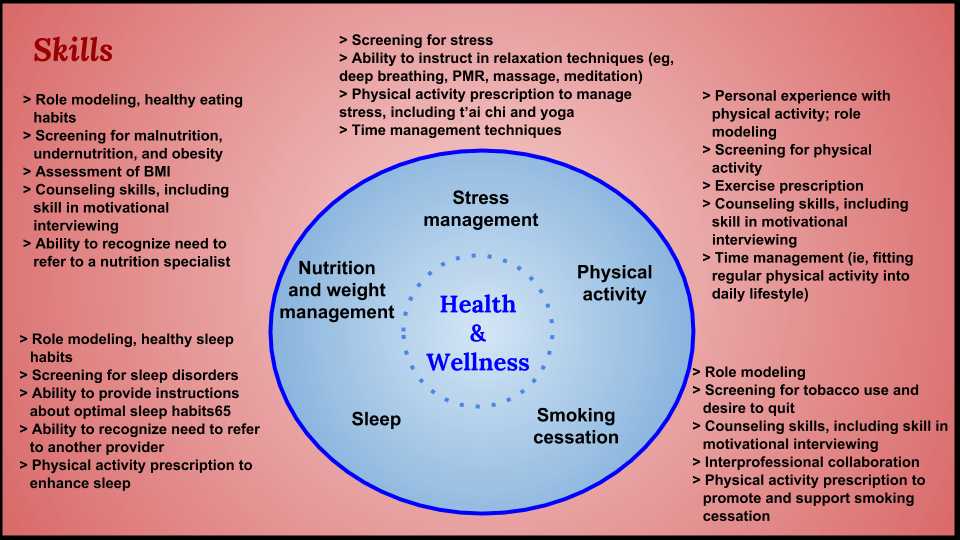“Do you exercise three times per week?”
“Do you eat 5 servings of fruits and vegetables?”
“Do you smoke cigarettes?”
“Do you get 7-8 hrs of sleep each night?”
Simple as they see, these questions may begin a deep transformation in the life of your patients if followed by skilled treatment and counseling.

In a previous blog, we talked about the leading role that physical therapists can play in preventing, reversing, and managing lifestyle-related chronic conditions” (1). Focusing on definitions and practice guidelines that appeared in a 2015 research article published in the journal Physical Therapy by Dr. Janet Bezner, PT, Ph.D. we introduced the concepts of Health and Wellness, what these terms mean, and how they overlap and differ (2).
[Go here for How a Physical Therapist Can Promote Health and Wellness Part 1]
We also highlighted 5 key behaviors associated with attaining health and wellness, and the knowledge base required by physical therapists to motivate their patients to adopt lifestyle changes (1).
- Physical activity
- Nutrition and weight management
- Smoking cessation
- Sleep
- Stress management
Below we will highlight important skills that physical therapists need to effectively promote health and wellness in their practice, as well as opportunities and barriers they encounter in trying to achieve this goal.
More Skills, Fewer Pills: Incorporating Wellness into PT Practice
Knowing what to say and do when your patient answers “no” to one or more of the questions above (or “yes” when asked about stress) will require fundamental knowledge about 5 key behaviors, pathophysiological implications, informational and educational resources. (check our previous blog) the following skills:

Common skills that can be applied in every case include:
- Role modeling (own experience and attitude; lead by example!) (3)
- Screening, to identify disease symptoms and risk factors.
- Motivational interviewing techniques, to encourage behavior change. (4, 5)
- Ability to discern when a patient needs to be referred to a physician or specialist (interprofessional collaboration).
A quick look at the figure reveals a prevalent motive among all suggested skills, namely non-treatment prescription of physical activity. Indeed, research shows that regular physical activity fosters positive outcomes in all 5 behaviors and decreases all-cause mortality risk by 20% to 30% compared with insufficient activity (6). This fact emphasizes the crucial role a physical therapist may play in the primary prevention of chronic diseases and chronic pain.
More skills = less pills Share on XPersistent Pain to Long-Lasting Gain
Sore shoulders. Stiff joints. Pain is the common link between most chronic medical conditions and the main reason people seek the help of a physical therapist. It is only logical that a conversation with your patient or client about treating and healing their pain should start by clearly assessing his or her concerns, motivations, and expectations. This podcast How to Assess and Interview Patients about their Pain Experience offers valuable guidance to start off a solid and trustful relationship with your new patient, and to shore up your efforts to promote the lifestyle changes needed to remain pain-free and healthy.
Barriers to Promote Health and Wellness
Several surveys identified the main perceived barriers to incorporating health and wellness promotion into physical therapist practice (7, 8,9). These include:
- Lack of time
- Lack of education
- Lack of counseling skills
- Lack of reimbursement
- Lack of resources
- Lack of self-efficacy
- Focus on secondary and tertiary (rather than primary) prevention
- Patient/client lack of interest
Interestingly, the Second Physical Therapy Summit on Global Health report identified an overarching theme, the “lack of profile and visibility of the profession and capacity to practice based on evidence”, as a main drawback to enhancing the delivery of health promotion and wellness services in the context of daily physical therapist practice (4). Further barriers include “the lack of involvement of physical therapists in research, policy, and action related to health promotion and wellness; payment systems based on illness rather than wellness; lack of recognition of physical therapists as primary care practitioners; and lack of emphasis on health promotion in entry-level education programs (2, 4)”. All of these challenges can be overcome by increased advocacy by the APTA to promoting the role of physical therapists in public health initiatives.
Pain is a common chronic medical condition and the main reason people to seek help from a physical therapist Share on XDr. Tatta’s simple and effective pain assessment tools. Quickly and easily assess pain so you can develop actionable solutions in less time.
Opportunities to Promote Health and Wellness
Fortunately, there are ample opportunities for physical therapists to successfully impart positive lifestyle changes in their patients (10). Doing so requires a renewed mindset in which physical therapists shift the focus from a biomedical approach (centered on the disease or injury) to a biopsychosocial or ecological approach (where the physical therapist thinks and acts holistically and within a larger context outside the patient/client model) (2).

Opportunities for promoting health and wellness include:
- Current public health priorities and causes of morbidity and mortality
- Patient/client motivation, attitude, and willingness to change
- Environmental (psychosocial) barriers to health behavior changes
- The importance of engaging in continuing professional education to build competency in health behavior change
- The benefits of partnering with other health care practitioners to ensure that health-promoting interventions are coordinated and reinforced
A Niche for Growth in Physical Therapy Practice
Physical therapists have an opportunity to embrace and take an active role in primary prevention of chronic pain and to provide education about the connection between behaviors such as physical activity, nutrition, stress reduction, sleep, health education, and health.
The paradigm shift has widened and with that so can your scope, influence, interventions, and outcomes in physical therapy practice.
Do you talk to your patients about lifestyle choices and disease prevention?
Click here to learn how to use nutrition to treat chronic pain!
Do you talk to your patients about lifestyle choices and disease prevention? Share on XREFERENCES
1- Dean, E. et al. (2011) The First Physical Therapy Summit on Global Health: implications and recommendations for the 21st century. Physiother Theory Pract. 27(8):531-547.
2- Bezner, J.(2015) Promoting Health and Wellness: Implications for Physical Therapist Practice. Physical Therapy 95 (10):1433–1444.
3- Black B., Marcoux, B.C., Stiller, C., Qu, X., Gellish, R. (2012) Personal health behaviors and role-modeling attitudes of physical therapists and physical therapist students: a cross-sectional study. Phys. Ther. Nov;92(11):1419-36.
4- Dean, E. et al. (2014) The Second Physical Therapy Summit on Global Health: developing an action plan to promote health in daily practice and reduce the burden of non-communicable diseases.Physiother. Theory Pract. 30 (4):261-75.
5- Rollnick S, Miller WR, and Butler CC. (2008). Motivational Interviewing in Health Care: Helping Patients Change Behavior. New York, NY: The Guilford Press.
6- Lee, I. M., & Skerrett, P. J. (2001). Physical activity and all-cause mortality: what is the dose-response relation?. Medicine & Science in Sports & Exercise 33 (6): S459-S471.
7- Goodgold, S. (2005) Wellness promotion beliefs and practices of pediatric physical therapists Pediatr Phys Ther 17:148-157
8- Shirley, D., Van der Ploeg, H. P., & Bauman, A. E. (2010). Physical activity promotion in the physical therapy setting: perspectives from practitioners and students. Physical therapy 90 (9): 1311-1322.
9- Verhagen, E., & Engbers, L. (2009). The physical therapist’s role in physical activity promotion. British journal of sports medicine 43 (2):99-101.
10- Frerichs, W., Kaltenbacher, E., van de Leur, J. P., & Dean, E. (2012). Can physical therapists counsel patients with lifestyle-related health conditions effectively? A systematic review and implications. Physiotherapy theory and practice, 28 (8): 571-587.



